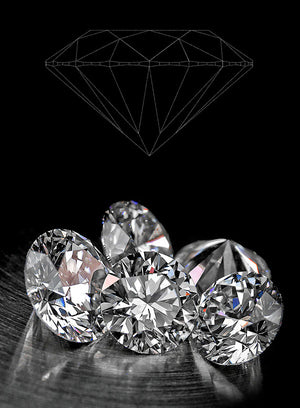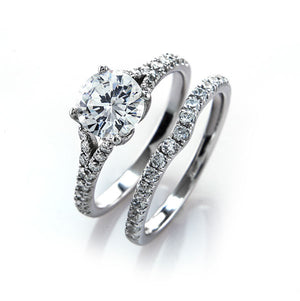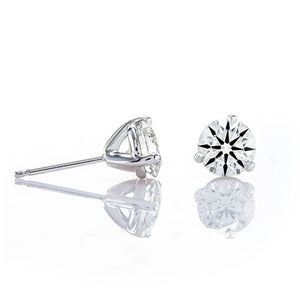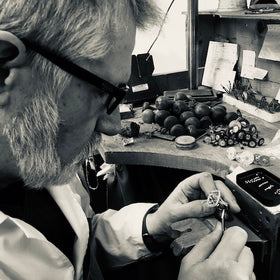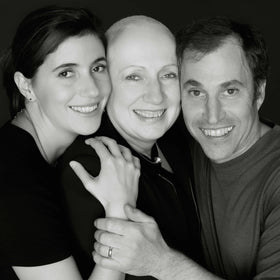
What is the best color for diamond earrings?
Once you determine the best clarity for diamond earrings, you probably want to know what the best color for diamond earrings is. Just as with diamond clarity, deciding what the best color is for diamond earrings is largely a matter of personal preference. This article will assist you in determining which diamond color is the best choice for the pair of diamond stud earrings which you select using the matched pair of diamonds search feature provided on the Brian Gavin Diamonds web site.
The first thing to understand about diamond color is that it is separated into two grading scales, one which is used to describe subtle variances of tone within white diamonds which we will be discussing today, and another which is used to describe the actual color of fancy colored diamonds like those which are blue, brown, green, orange, pink, and yellow. The grading scale for white diamonds is broken down into sections which are actually intended to represent an absence of color, with each individual color grade being represented by a letter, beginning with D-color, which is the highest color grade.
When discussing the different color grades with people, I often use the analogy of white printer paper to describe the subtle difference which is visible throughout the grading scale for white diamonds because it is easy for people to visualize the difference. Think of the different shades of white paper which you have seen over the years, photo quality paper tends to be a bright white which is absent of color, while standard copy paper tends to exhibit more color in various shades depending on the manufacturer. Although there are subtle differences in the tonal value of the different sheets of paper, most people would still describe them as white, but if asked which pieces of paper were “brighter” then they would most likely select the photo quality paper. As you can see from the diamonds pictured in the photograph below, the visual difference between each color grade is extremely slight.
Colorless Diamonds in the D-E-F Color Range:
Most people evaluating “colorless diamonds” which are those graded as being D, E, or F in color, would most likely describe them as being brighter and whiter than diamonds in the subsequent categories of near-colorless, faint yellow, and yellow. However it is important to understand that the term “brightness” is used by the diamond industry to describe the tonal value of a diamond, and also the volume of light return being reflected by a diamond as a result of the proportions and overall diamond cut quality… thus a D-color diamond can be bright due to an absence of color, but even brighter if it has been cut to a range of proportions which is optimized to produce a higher volume of light, and cut to a higher level of optical precision which results in more sparkle, like the diamonds featured in the Brian Gavin Signature and Brian Gavin Blue collections.
Since white diamonds are graded upon an absence of color, diamonds in the D-E-F colorless range exhibit less color than other diamonds, but it is important to understand that the difference between shades of color is just that, subtle shades of difference. Thus many people will not readily notice a difference between something like an F-color and G-color diamond, with G-color being the beginning of the near-colorless range of color.
Near-colorless Diamonds in the G-H-I-J Color Range:
I think that most people would describe diamonds in the near-colorless range of G-H-I-J as “white” because that is certainly how they appear to me, with G-color just being a little brighter or lighter in tone than a J-color diamond which will exhibit just a little more warmth in terms of tone.
Thus if you presented somebody with a pair of diamond earrings, such as this pair of 0.839 carat total weight, F-color, SI-1 clarity, Brian Gavin Signature round diamonds, or this pair of 1.095 carat total weight, H-color, SI-2 clarity, Brian Gavin Signature round diamonds, and asked them to describe the color, they would most likely describe both pairs as being white in color. However the second pair is larger and only costs about $500 more despite the price increase which occurs between the 0.49 – 0.50 carat marks, because of the slight difference in color and clarity.
Faint Yellow Diamonds in the K-L-M-N Color Range:
Although the gemological terminology uses the term “faint yellow” to describe diamonds in the K-L-M-N range of color, I view it more as a warmth in tonal value because the subtle difference in color do not present “yellow” in the intensity of color that most people imagine something described as yellow to be… it’s like I would describe a glass of lemonade made with a commercial mixture which contains yellow food coloring as “yellow” in color, but I would not describe a glass of water with the juice from an actual lemon squeezed into it to be yellow in color, but there would be a difference in the tonal value of the water as seen with and without lemon juice mixed into it.
Since the proportions of a diamond and the overall diamond cut quality contribute to how bright the diamond appears, I find that many people have difficulty determining the color of our round brilliant cut diamonds from a face-up vantage point due to the increased volume of light return and sparkle factor. Thus quite a few of our customers select “faint yellow diamonds” such as those in the K-L-M-N color range for center stones in engagement rings and earrings because doing so enables them to buy a larger diamond without sacrificing visual performance.
Which Color Diamond Should You Choose for Diamond Earrings?
Once again, which diamond color grade you select for earrings comes down to a personal preference, or perhaps your personal ability to perceive color, or more accurately an absence of color in diamonds. I find that people who work in fields where subtle difference in color are critical factors, such as graphic artists, photographers, lighting architects, etc., often prefer diamonds which are higher in color, meaning those in the Colorless Range of D-E-F and perhaps G-H color from the near-colorless range. While the majority of people who are not color sensitive, are perfectly happy with diamonds selected from the I-J near-colorless range all the way down to L-M color which is supposed to be faint yellow, but which really just looks a little warmer in tone than diamonds of higher color.





